At first glance, buying email lists seems like the quick fix to expand your marketing reach. But the allure of instant access to millions of emails can quickly turn into disappointment if the lists don’t deliver on their promises.
Many providers fall short, offering outdated or non-compliant email lists for sale that can harm your email marketing campaign more than help.
In this post, we’ll go over the key things to consider when buying email lists: legal compliance, data freshness, lead qualification, deliverability and more.
(Ignore these and you could be in for some serious trouble for your business – from wasted resources to legal penalties.)
Find out what to look for in a provider, why you should only choose verified lists and who the top providers are so you can make an informed decision that fits your business goals and marketing plans.
Let’s get started.
Best 17 Email List Providers Compared
The best places to buy email lists include reputable providers specializing in email marketing lists. These providers ensure high-quality, targeted lists that align with your business needs. It’s critical to select platforms that offer up-to-date and compliant databases to maximize your marketing strategies effectively.
Here’s an overview of all email list tools and providers we’ve tested:
| Name | Total Score | G2 Rating | # of G2 Reviews | Capterra Rating | # of Capterra Reviews |
| 🥇 UpLead | 4.7 | 4.8/5 ⭐ | 759 | 4.6/5 ⭐ | 76 |
| Apollo | 4.6 | 4.8/5 ⭐ | 6,994 | 4.6/5 ⭐ | 344 |
| Cognism | 4.6 | 4.6/5 ⭐ | 688 | 4.6/5 ⭐ | 125 |
| EasyLeadz | 4.6 | 4.6/5 ⭐ | 1,273 | – | – |
| Lead411 | 4.5 | 4.5/5 ⭐ | 464 | 4.7/5 ⭐ | 61 |
| Hunter | 4.5 | 4.4/5 ⭐ | 544 | 4.6/5 ⭐ | 618 |
| LakeB2B | 4.5 | 4.5/5 ⭐ | 2 | – | – |
| Rocketreach | 4.5 | 4.5/5 ⭐ | 755 | 4.2/5 ⭐ | 131 |
| Kaspr | 4.4 | 4.4/5 ⭐ | 747 | – | – |
| SalesIntel | 4.3 | 4.3/5 ⭐ | 335 | 4.4/5 ⭐ | 33 |
| LeadIQ | 4.2 | 4.2/5 ⭐ | 779 | 4.4/5 ⭐ | 24 |
| Skrapp | 4.2 | 4.0/5 ⭐ | 126 | 4.5/5 ⭐ | 56 |
| ZoomInfo | 4.1 | 4.4/5 ⭐ | 8,439 | 4.1/5 ⭐ | 286 |
| Lusha | 4.0 | 4.3/5 ⭐ | 1,46 | 4.0/5 ⭐ | 363 |
| Seamless ai | 4.0 | 4.3/5 ⭐ | 2,675 | 3.7/5 ⭐ | 149 |
| D7 Lead Finder | 3.4 | 3.4/5 ⭐ | 5 | – | – |
| LeadsGorilla | 3.2 | 3.3/5 ⭐ | 4 | 3.2/5 ⭐ | 6 |
We’ve calculated the total score based on this calculation:
Total score = (G2 rating * # of G2 reviews) + (Capterra rating + # of Capterra reviews) / (# of G2 reviews + # of Capterra reviews)
Let’s have a look at all the tools in detail.
1. UpLead
Why Choose UpLead for Your Email List Needs?
Enhance your prospecting with UpLead. It’s all about getting the right, verified email addresses for your outreach campaigns.
- Verified Email Addresses: Access a vast pool of over 140 million contacts with UpLead, each with a 95% accuracy guarantee for email addresses. We ensure you connect with the right inboxes every time.
- Instant Email List Creation: Say goodbye to outdated lists. With UpLead, create up-to-date, targeted email lists in real-time. Our platform refreshes with every click, ensuring you have the most current email addresses.
- Tailored Email Contacts: Use UpLead’s advanced search to find email addresses that match your specific criteria. With over 50 filters, target the exact audience for your email campaigns, ensuring higher open and conversion rates.




Book a demo
Full Name cannot be empty
Not a valid e-mail address
- Up to 170
- 170-399
- 400-999
- 1000+
Call us: (800) 493-4084
UpLead is a tool to buy email lists that stands out by giving you access to over 160 million professional profiles worldwide. With a promise of 95% accuracy, it guarantees verified email addresses, ensuring high-quality leads for your business.
UpLead is not just about buying email mailing lists; it enhances your marketing strategy by providing real-time email verification, extensive filters for targeted searching, and integration with over 1,500 platforms.
Whether you want to buy business email lists or create targeted marketing campaigns, UpLead’s real time prospecting and advanced search capabilities makes it the go to platform.
Pricing
- Free trial: $0/month
- Essentials: from $74/month
- Plus: from $149/month
- Professional: Custom pricing
Features
- 95% Data Accuracy Guarantee: UpLead commits to high accuracy in contact data.
- Extensive Search Filters: Use over 50 criteria for precise prospect targeting.
- Advanced Prospecting: Access over 160 million B2B profiles for lead generation.
- Real-time Email Verification: Ensures high deliverability by verifying emails instantly.
- Mobile Direct Dials: Get mobile & direct dial phone numbers for prospects
- Instant List Updates: Keeps data fresh with real-time refreshes as filters are applied.
- Chrome Extension: Easily gather email addresses from LinkedIn or websites.
- Intent Data: Get ready-to-buy prospects actively looking for your solution.
Reviews
Capterra: 4.6/5 ⭐ (76 reviews)
G2: 4.7/5 ⭐ (759 reviews)
Start with UpLead today and grab 5 free leads.
Apollo
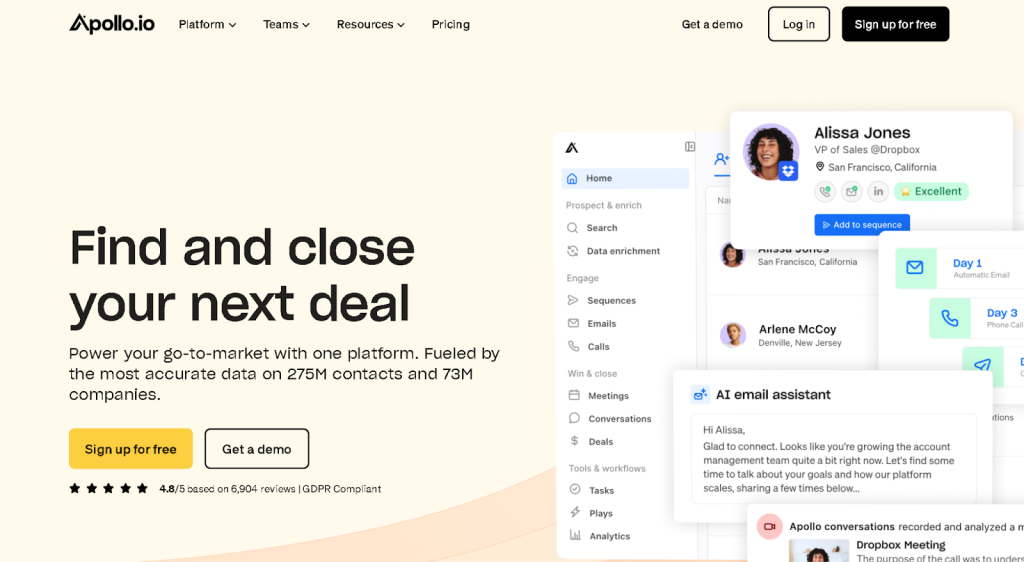
Apollo.io is godd for segmenting databases for email list buyers. Trusted by over a million professionals it automates email campaigns, integrates with CRMs and social platforms like LinkedIn and maintains email list hygiene. It helps you manage your contacts to boost engagement.
Pricing
- Free: $0
- Basic: from $49/user/month
- Professional: from $79/user/month
- Organization: from $119/user/month
Here, you can learn more about the Apollo pricing.
Features
- Email Automation: Apollo simplifies your email marketing efforts by automating tasks like segmenting subscribers, executing marketing sequences, scheduling, and generating performance reports.
- Affordable Market Expansion: With Apollo, expand your reach affordably using curated email lists, tapping into an audience that’s already shown interest.
- Email Templates: Apollo offers ready-to-use email templates and snippets, enabling quick campaign launches.
- Risk Reduction: Minimize campaign risks with Apollo’s A/B testing, detailed analytics, and data reliability, enhancing your outbound success.
If Apollo doesn’t look like a fit to you, have a look at the best Apollo.io alternatives.
Reviews
Capterra: 4.6/5 ⭐ (344 reviews)
G2: 4.8/5 ⭐ (6,994 reviews)
Lead generation doesn’t have to be all that painful. With UpLead, you can easily connect with high-quality prospects and leads to grow your company.
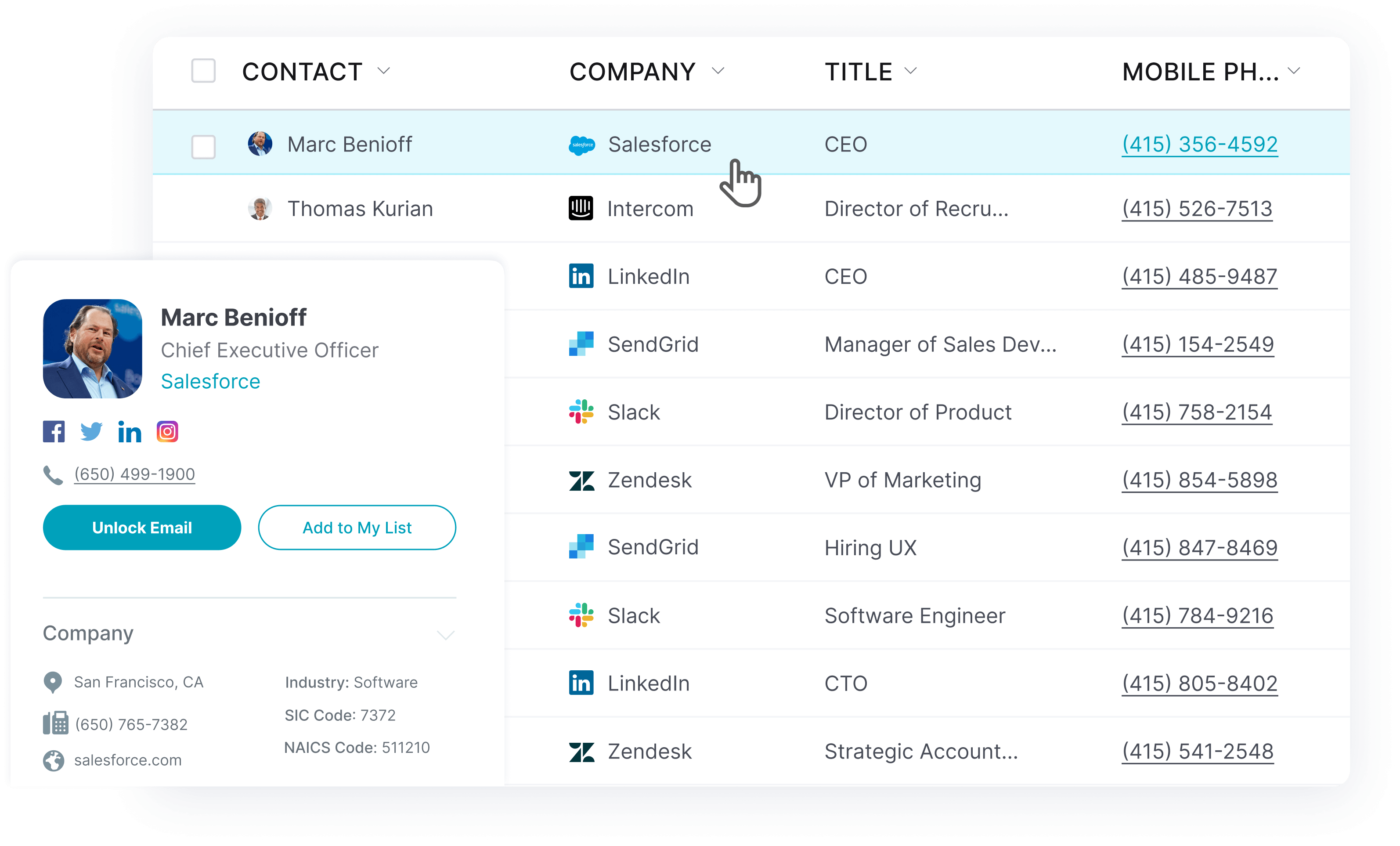
Cognism
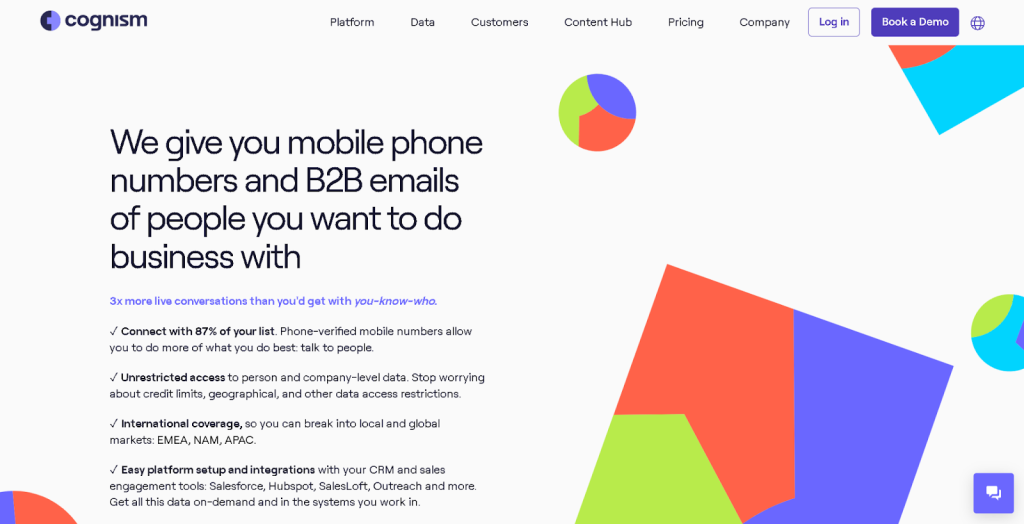
Cognism is a B2B sales intelligence tool that helps you create and buy targeted email lists for global campaigns. It’s a platform where you can search the database and build lead lists that match your Ideal Customer Profile (ICP) and export validated emails to CRM or sales tools.
This tool is GDPR and CCPA compliant and ISO certified so you can expand your reach while being privacy compliant. It integrates with sales and marketing platforms like Salesforce and HubSpot so you can use your data seamlessly.
Pricing
- Custom pricing (find more information about the Cognism pricing)
Features
- Targeted Email Lists: Cognism allows you to create specialized email lists for international campaigns and reach high-value prospects.
- Data Compliance: Ensures email lists are GDPR and CCPA compliant so you can market ethically and legally.
- CRM Integration: Integration with leading CRMs like Salesforce and HubSpot for smooth workflows.
- Intent-Based Data: Consent-based intent data to find potential customers and boost your marketing campaigns.
Reviews
Capterra: 4.6/5 ⭐ (125 reviews)
G2: 4.6/ 5 ⭐ (688 reviews)
(If you’re looking for something similar to Cognism: UpLead is a great Cognism alternative.)
EasyLeadz
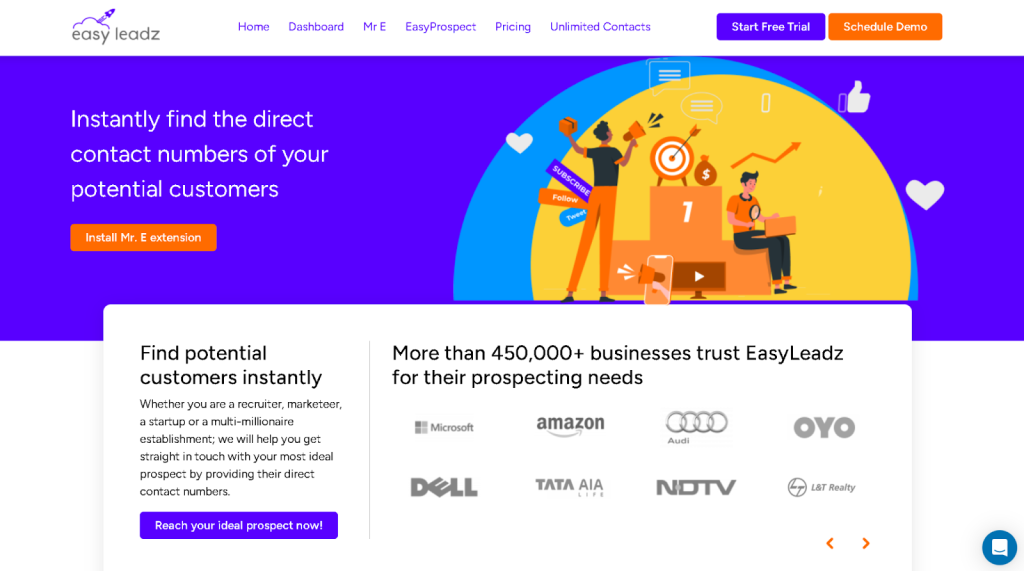
EasyLeadz is a B2B contact data provider that offers real-time contact list creation with high accuracy and direct access to decision-makers. It has tools like Mr. E to extract direct contacts from LinkedIn and EasyProspect to target SME businesses. API integration for database enrichment is also supported.
Pricing
- Custom pricing
Features
- Real-Time Data Verification: The platform verifies and updates contact information in real-time to minimize bounce rates.
- Advanced Filtering: Filter prospects by job title, industry, location and company size for highly targeted outreach.
- CRM Integration: EasyLeadz integrates with popular CRM systems to import and manage contacts easily.
Reviews
Capterra: –
G2: 4.6/ 5 ⭐ (1,273 reviews)
Lead411
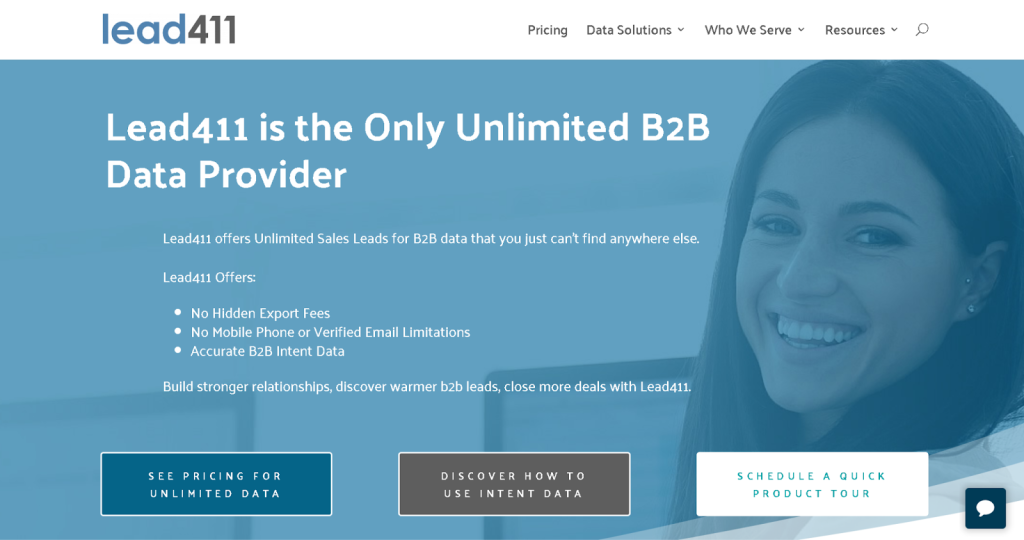
Lead411 is a B2B email list provider that offers subscriptions to their B2B email database. They have a high verified email rate thanks to their triple verification process that combines algorithms, A.I. and human research. Customers can filter their email lists by job titles, company size and industry etc. They also offer additional data like social profiles and direct dial phone numbers so you can get complete information when you buy marketing lists.
Pricing
- Free trial: $0 (7 Days)
- Basic Plus Unlimited: from $75/user/month
- Enterprise Limited: Custom pricing
- Pro with Bombora Intent: Custom pricing
Features
- Triple Verified Emails: Lead411 verifies their emails with SMTP checks, human validation and email open confirmation.
- Advanced Search: Filter by job title, company size and more to target your campaigns.
- Data Integrations: Integrates with over 25 CRMs and marketing platforms.
- Direct Dial Numbers: Double checked phone numbers.
Reviews
Capterra: 4.7/5 ⭐ (61 reviews)
G2: 4.5/5 ⭐ (464 reviews)
Hunter
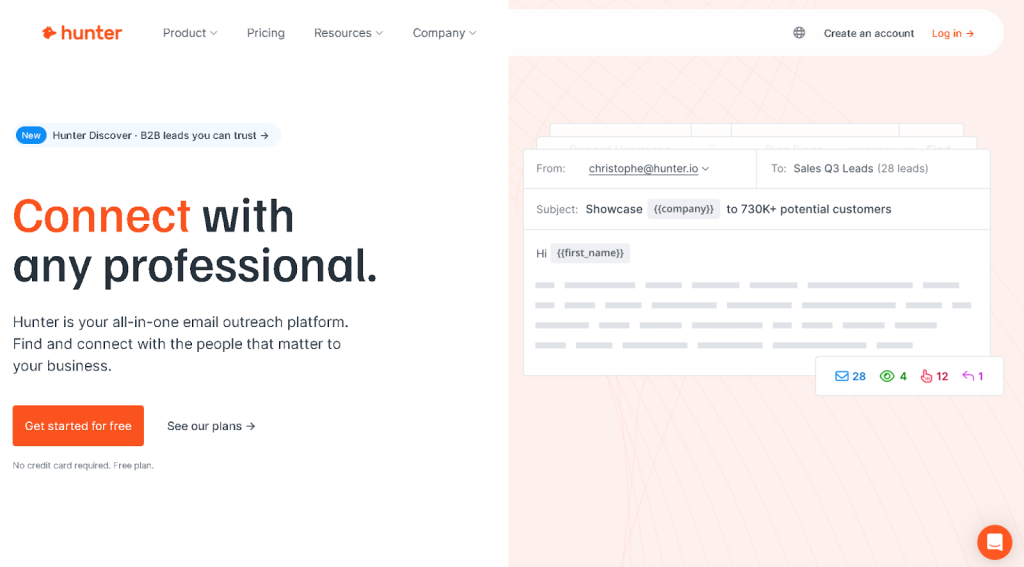
Hunter.io is known for finding and verifying professional email addresses and has over 4 million users. They offer domain search, email finding and verification tools and ensure high quality data GDPR compliant. Good for building and buying email lists, Hunter.io is easy to use but can also get expensive (check Hunter’s pricing).
Pricing:
- Free: $0/year
- Starter: from $34/month
- Growth: from $104/month
- Business: from $349/month
- Enterprise: Custom pricing
Features
- Domain Search: Find the best contact for a company name or website and tailor your approach to your ideal customer profile.
- Email Finder: Use a name to find a verified email address and get the most out of your list with high accuracy.
- Email Verifier: Improve your sender reputation by ensuring email addresses are valid and can receive messages and reduce bounces.
- Bulk Tasks: Manage large volumes of email addresses by performing bulk search, check and verification.
Reviews
Capterra: 4.6/5 ⭐ (618 reviews)
G2: 4.4/ 5 ⭐ (544 reviews)
If you’re looking for similar solutions, check out these Hunter.io alternatives.
LakeB2B
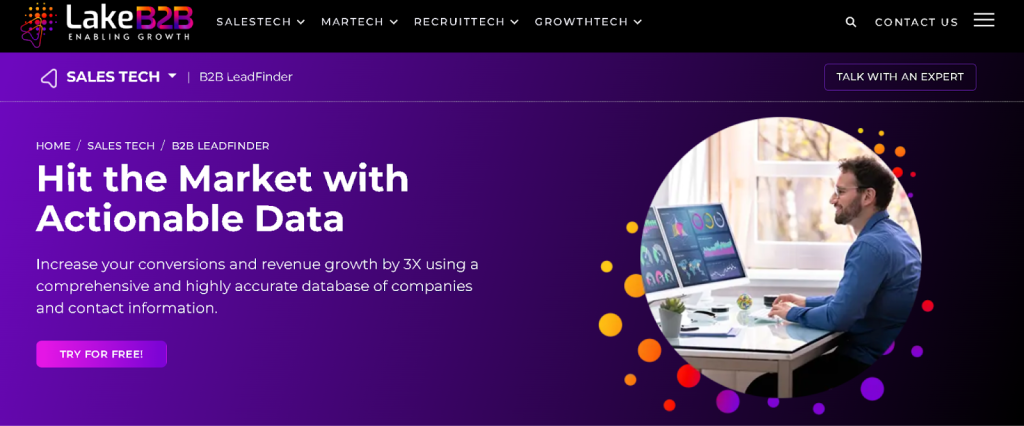
LakeB2B has been providing B2B email lists for over 10 years and has data from reliable sources and 95% deliverability. They offer custom and segmented lists to fit your needs including multiple contact information for full marketing.
Specialized in Health, Education and Legal Services, LakeB2B helps you target your target audience with minimal effort.
Pricing
- Free demo: $0, afterwards custom pricing
Features
- Verified Email Lists: LakeB2B offers pre-verified and ethically sourced email lists to minimize email bounce rates and comply with CAN-Spam Laws.
- Downloadable CSV: Download email lists in CSV and integrate them into your CRM or marketing automation platforms for instant use.
- Deliverability: LakeB2B guarantees 95% deliverability so your emails reach the right people without high bounce rates.
- Accurate and Up-to-Date Data: Data is regularly cleansed and updated to remove inaccuracies.
- Customizable and Segmented Lists: They offer email lists based on specific criteria like region, interests or behavior.
Reviews
Capterra: –
G2: 4.5/ 5 ⭐ (2 reviews)
Rocketreach
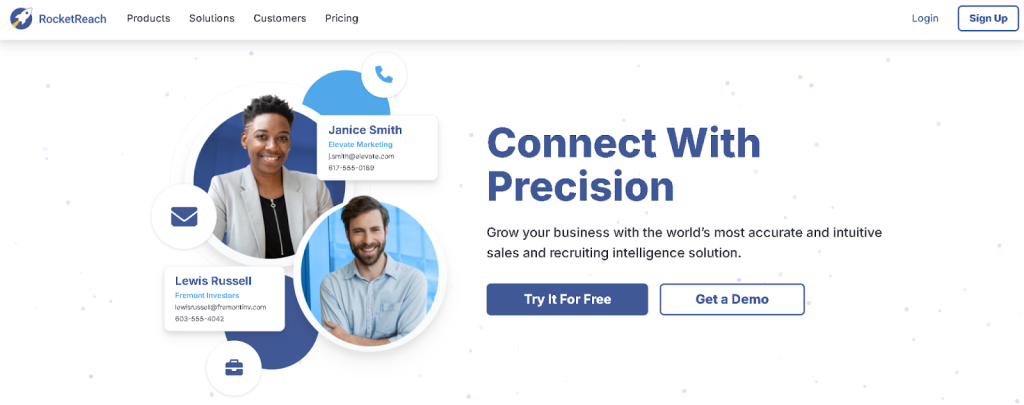
RocketReach provides global email and phone contact data with a 90-98% deliverability rate for verified emails.
You can create custom contact and company lists that update automatically based on location and industry. RocketReach also has intent data to find potential buyers and AI powered recommendations to find new contacts.
It integrates with CRM and marketing automation platforms and also has an API for data enrichment.
Pricing
- Free: $0
- Essentials: from $39 per month
- Pro: from $99 per month
- Ultimate: from $249 per month
Features
- Database: Access a database of over 275 million verified contacts categorized by industry, company size and job title.
- Verified Email Lists: Get email lists that have gone through a multi-step verification process.
- Advanced Filtering: Create super targeted email lists with advanced filtering by seniority level, technology usage and intent data.
- Integrations: Integrate your acquired email lists into your CRM and marketing automation tools or export as CSV files.
- LinkedIn Integration: Enhance your email lists by importing and enriching contact information from LinkedIn profiles.
- Real-time Data Enrichment: Keep your contact data up to date and accurate with real-time data enrichment.
Reviews
Capterra: 4.2/5 ⭐ (131 reviews)
G2: 4.5/ 5 ⭐ (755 reviews)
Kaspr
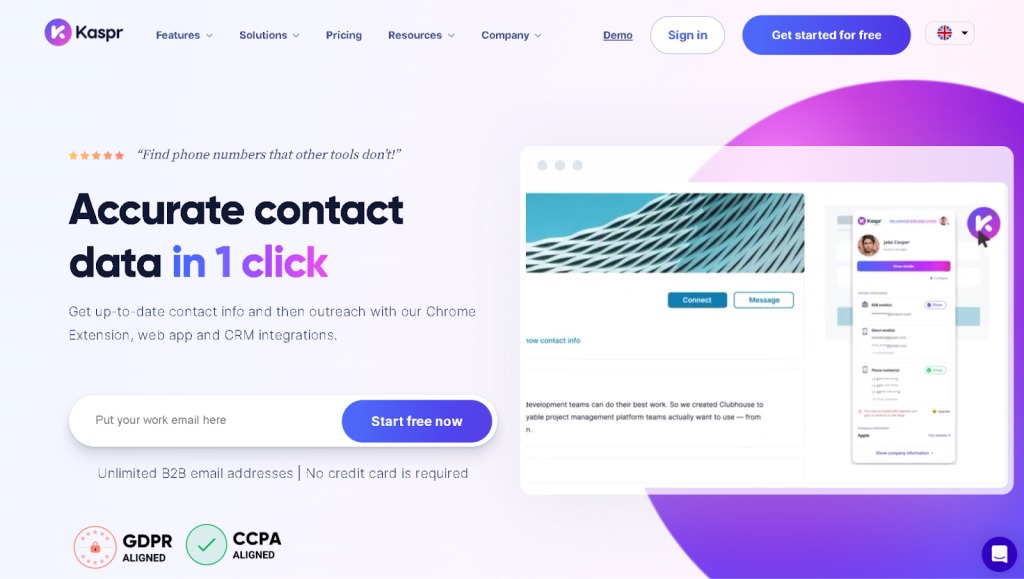
Kaspr has access to email lists with over 500 million phone numbers and email addresses for B2B lead gen. It works for individual SDRs, small sales teams and recruiters. Kaspr has a Chrome Extension and offers different CRM integrations. The tool also provides you with real-time data verification from 150 B2B data sources. It’s GDPR and CCPA compliant and you can get email addresses and phone numbers in the US and Europe.
Pricing
- Free: £0
- Starter: £39 user/month
- Business: £69 user/month
- Organization: £85 user/month
Features
- Up-to-Date Contact Information: Get current contact details including phone numbers and email addresses verified against 150 providers and updated in real-time.
- Unlimited B2B Contacts: Get unlimited B2B email contacts across all plans including the free plan.
- LinkedIn Integration: Chrome Extension to get contact details from LinkedIn profiles including Sales Navigator and Recruiter Lite.
- CRM and Marketing Automation Sync: Integrates with leading CRM and marketing automation tools like HubSpot, Pipedrive, Lemlist and Salesforce for data sync and workflow.
- Compliance: Fully GDPR and CCPA compliant
- User Friendly Interface: Dashboard to manage leads including list creation, note taking and task assignment.
Reviews
Capterra: –
G2: 4.4/ 5 ⭐ (747 reviews)
SalesIntel
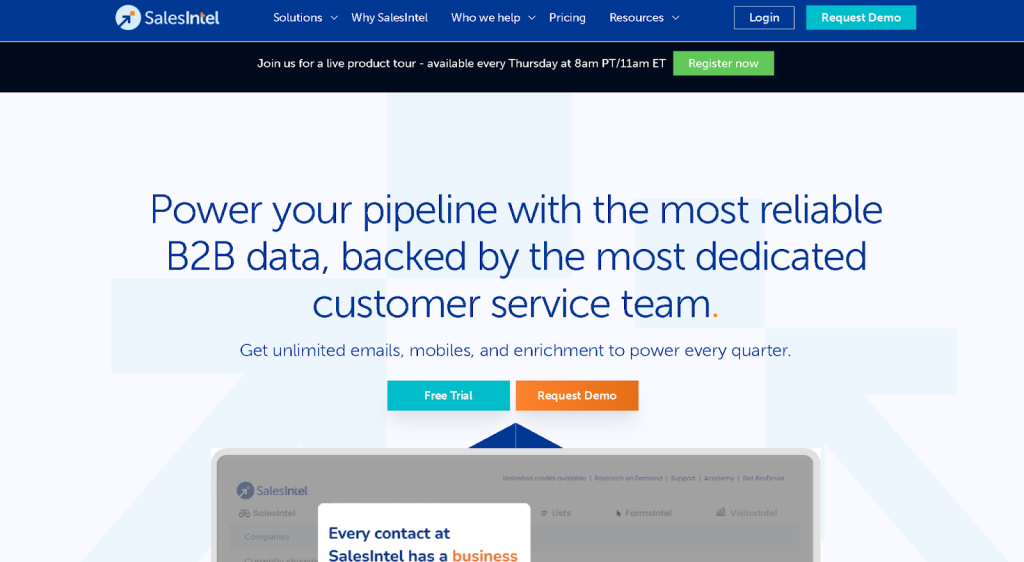
SalesIntel is a suitable software for buying email databases, with accurate and legally sourced contact information. They re-verify data every 90 days to ensure GDPR and CAN-SPAM compliance. SalesIntel allows you to target by industry, job title and company size and has dedicated customer support to improve your email marketing.
Pricing
- Individual: $69/month
- Teams: $199/month per user (billed annually)
- Unlimited Everything: Custom pricing
Features
- B2B Data: SalesIntel gives you curated B2B contact and account data, re-verified every 90 days for high accuracy.
- Legal Compliance: All contacts are opt-in and sourced legally (GDPR and CAN-SPAM compliant)
- Targeted Outreach: The platform’s segmentation allows you to buy lists for marketing and target industries, job titles, company sizes and other attributes to reach out to targeted leads.
- Detailed Insights: SalesIntel gives you firmographic and technographic data so you can understand your prospects better and focus on the most promising accounts.
- Buyer Intent Data: Access to intent signals so you can prioritize accounts effectively.
- Data Enrichment: SalesIntel can add accurate, up-to-date data to your CRM and lead forms.
Reviews
Capterra: 4.4/5 ⭐ (33 reviews)
G2: 4.3/ 5 ⭐ (335 reviews)
LeadIQ
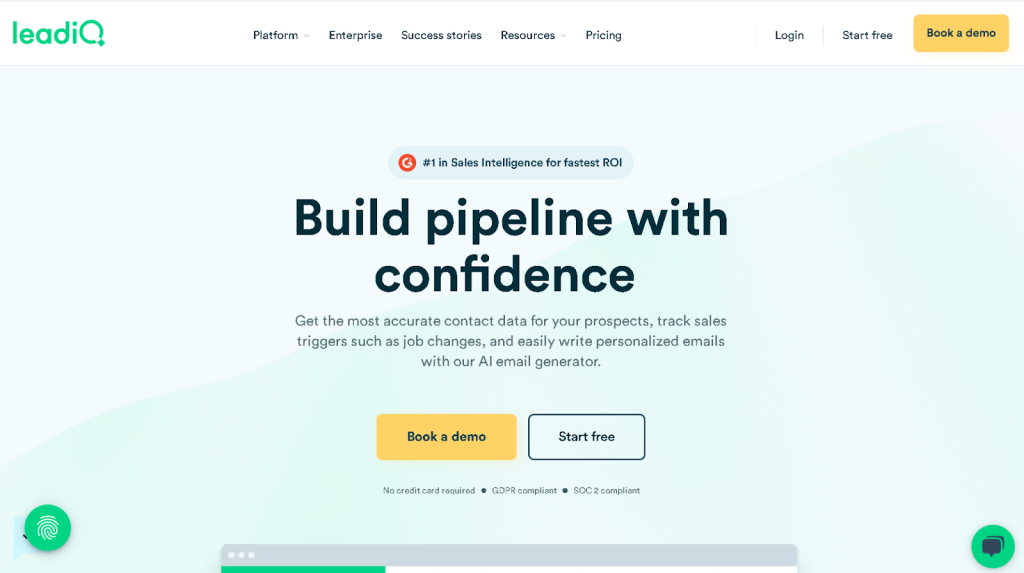
LeadIQ is a full platform for sales teams to buy email lists for marketing. It simplifies the process of finding and capturing B2B contact data so you can personalize outreach at scale.
With a focus on data accuracy LeadIQ uses real-time verification and multiple layers of data verification from a mix of public and private databases, social media and user contributed information.
So you have access to millions of verified profiles, emails and mobile numbers. LeadIQ also integrates with all major CRMs and sales engagement tools.
Pricing
- Freemium: $0/year
- Essential: from $39/month
- Pro: from $79/month
- Enterprise: Custom pricing
Features
- Contact Data: LeadIQ has millions of verified profiles, including emails and mobile numbers, checked in real-time for accuracy and quality.
- One-Click Workflow: Simplifies prospecting with a one-click workflow that integrates with your CRM and sales tools.
- AI Personalization: Enhances your outreach with AI written emails that are tailored to the recipient’s interests and needs.
- Integrations: Works with several sales and CRM platforms like Salesforce and Hubspot.
- Global Data Operations: A dedicated team continuously enriches and verifies the database by researching new public data sources and vendors so you have global coverage.
- Data Verification and Compliance: Multiple verification layers and data privacy regulations like GDPR and CCPA compliance.
Reviews
Capterra: 4.4/5 ⭐ (24 reviews)
G2: 4.2/ 5 ⭐ (779 reviews)
Skrapp.io
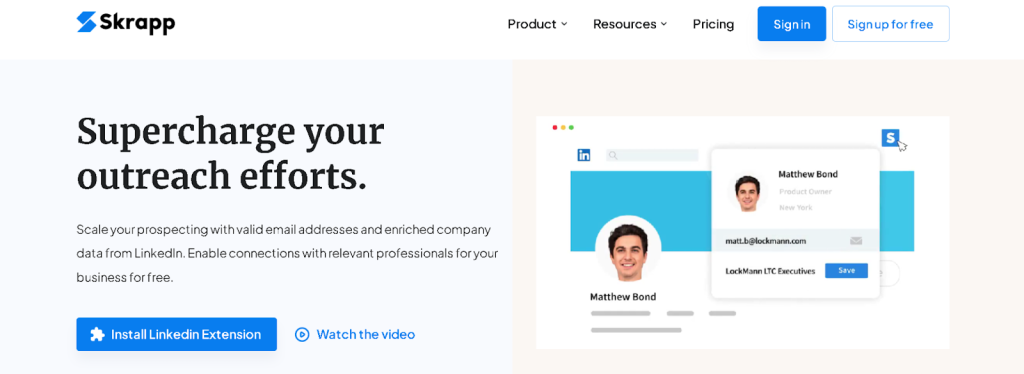
Skrapp.io is a B2B lead generation tool that gives you access to over 150M+ business profiles and company data for more than 20M+ businesses, updated daily. You can find verified business emails and enrich company data from LinkedIn and Sales Navigator in no time. With an 80% success rate in finding valid email addresses, it simplifies the process of buying email lists for marketing and sales purposes.
Pricing
- Free: $0
- Starter: from $30/month
- Seeker: from $375month
- Enterprise 20k: from $140/month
- Global 50k: from $225/month
Features
- LinkedIn Email Discovery: Find email addresses from LinkedIn and Sales Navigator and boost your email marketing.
- Email Verification: Verify your email lists and get high deliverability rates, reduce bounces and preserve your sender reputation.
- Advanced Filters: Filter your search with industry, company size, revenue and more to find the perfect prospects for your email campaigns.
- Bulk Email Extraction: Generate lists of potential leads with the bulk email finder and scale your email marketing.
Reviews
Capterra: 4.5/5 ⭐ (56 reviews)
G2: 4.0/ 5 ⭐ (126 reviews)
ZoomInfo
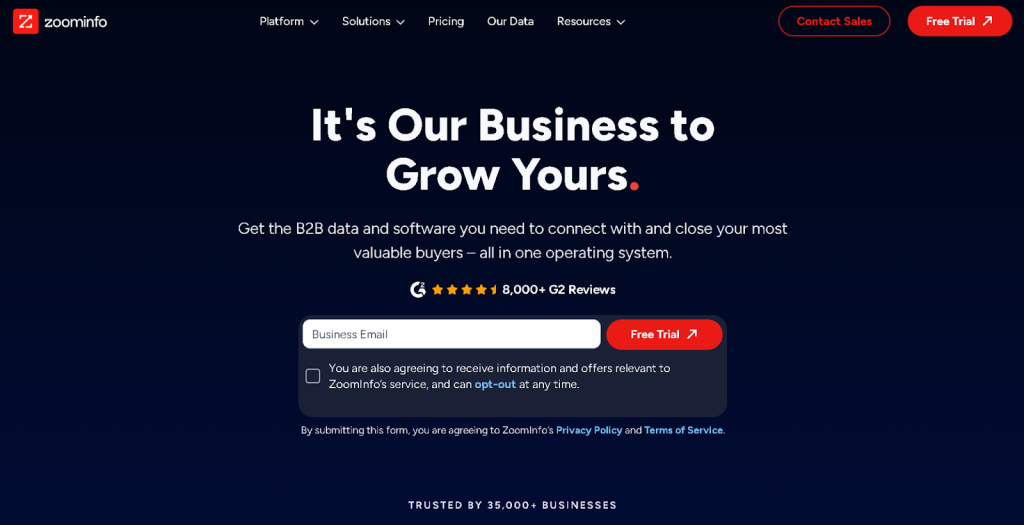
ZoomInfo is a platform to buy B2B contact data. It has direct dials and verified email addresses to reach potential buyers.
Professional profiles include job title, work experience, education and social media links, and you get notified when those profiles are updated.
Department/organization charts, decision-maker direct dials and emails, and company initiatives are also included.
ZoomInfo’s B2B search engine has over 300 company attributes to search. Contact tracker will alert you to changes in buyers’ job title and company affiliation so you can keep your contact lists up-to-date.
Pricing
- Professional: from $14,995/year
- Advanced: from $24,995/year
- Elite: from $39,995/year
Features
- B2B Contact Database: Get access to a database of 150 million verified email addresses and 65 million direct dial phone numbers.
- Advanced Search: Search for specific contacts and companies that match your Ideal Customer Profiles.
- Organizational Insights: Company profiles and org charts so you know the structure and key decision-makers at target companies.
- Browser Extension: Access ZoomInfo’s database from your browser with a Chrome extension
Reviews
Capterra: 4.1/5 ⭐ (286 reviews)
G2: 4.4/ 5 ⭐ (8,439 reviews)
Lusha
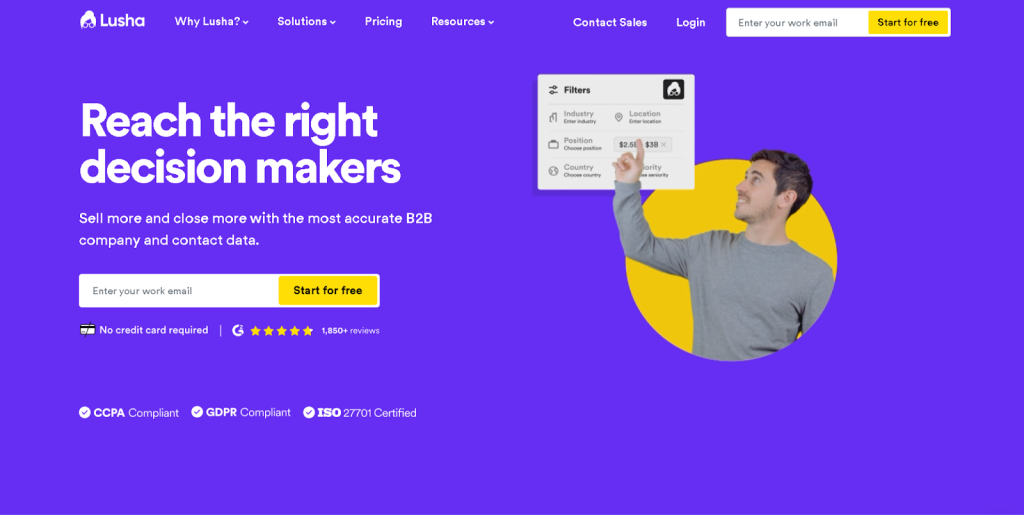
Lusha is a place to buy business email addresses and has millions of verified B2B contacts to buy email lists and build lists for outreach. It’s GDPR and CCPA compliant and legal to use. Lusha is known for easy integration with major CRM systems and its simple sign up process.
Pricing
- Free: $0
- Pro: from $36/user/month
- Premium: from $59/user/month
- Scale: Custom pricing
Features
- B2B Data: Get company and contact details to refine your sales approach and target better.
- CRM Data Enrichment: Add up to date contact and company data to your CRM and find new business.
- Advanced Search: Use advanced filters to create contact lists and find emails and direct dials fast.
- Integrations: Integrate Lusha with your existing CRM systems like HubSpot and Salesforce.
- Data Compliance: Lusha is GDPR & CCPA compliant.
Reviews
Capterra: 4.0/5 ⭐ (363 reviews)
G2: 4.3/ 5 ⭐ (1,460 reviews)
Did you know? UpLead is known as one of the best Lusha alternatives.
Seamless ai
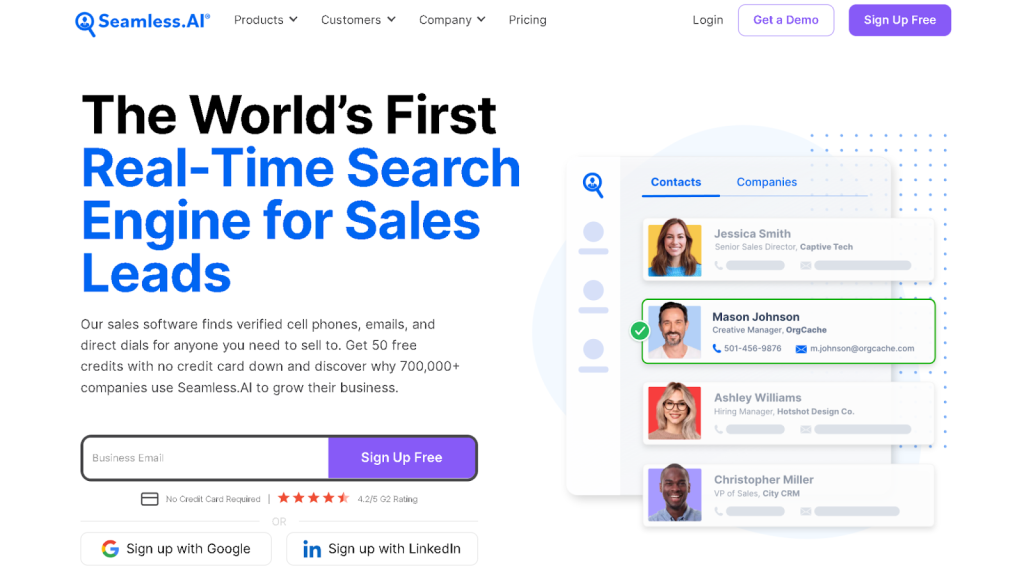
Seamless.ai is designed for generating accurate and compliant email lists, automating the process of finding and validating email addresses of key decision-makers. It’s suitable for sales, marketing and recruitment professionals to improve their B2B outreach.
Seamless.ai prioritizes real-time validation and marketing regulations. Their goal is to reduce the risk of bounced emails and reputation damage. Seamleass.ai offers an ethical way to expand your contact database.
Pricing
- Custom pricing
Features
- Contact Data: Get access to a database with emails, phone numbers and detailed information about company decision makers.
- AI Lead Generation: Use AI to build email address lists automatically. This feature automates the process of finding and validating email addresses of key decision makers.
- Custom Search: Use customizable search filters to find contacts by industry, revenue, job title, seniority and more.
- Data Enrichment: Fill in the gaps in your database with Seamless.AI’s data enrichment tool so your CRM and marketing automation platforms have the most current and complete data.
- Integrations: Integrate your new email lists into your CRM or marketing automation platforms or export as CSV files.
Reviews
Capterra: 3.7/5 ⭐ (149 reviews)
G2: 4.3/ 5 ⭐ (2,675 reviews)
D7 Lead Finder
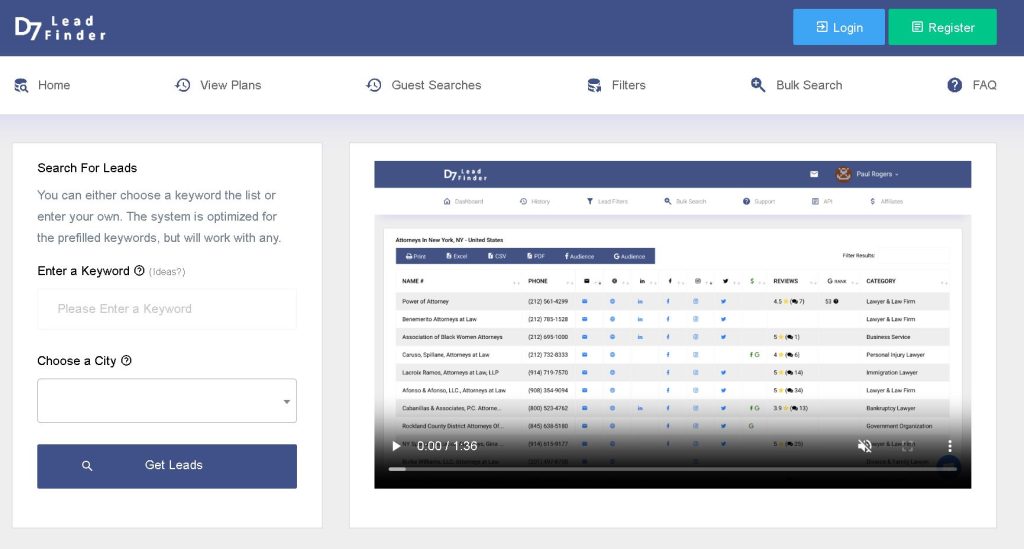
D7 Lead Finder is a lead generation tool that allows you to build B2B email lists. Enter a keyword and location and you can create custom lists with over 65 million leads across global locations.
Each search can give you up to 1200 business leads in 3 minutes with details like business name, email address, social media handles and more.
It supports worldwide search including US, Europe and Asia. Export options in CSV, Excel and PDF so you can manage your leads in any way you want.
Pricing
- STARTER: $39.99/month
- AGENCY: 54.99/month
- PROFESSIONAL: $119/month
Features
- Lead Data: Get access to a large database of over 65 million business leads from various industries and countries.
- Contact Information: Get complete business details including names, email addresses, website URLs, postal addresses and social media profiles across Instagram, LinkedIn, Facebook and Twitter.
- Social and Review Data: Get social media metrics like follower count and average likes and review scores from Yelp, Facebook and Google.
- Advertising and Technology Insights: See leads who are running paid ads and using technologies like Facebook Pixel, Google Remarketing and different email services like Google Apps and Outlook.
Reviews
Capterra: –
G2: 3.4/5 ⭐ (5 reviews)
LeadsGorilla
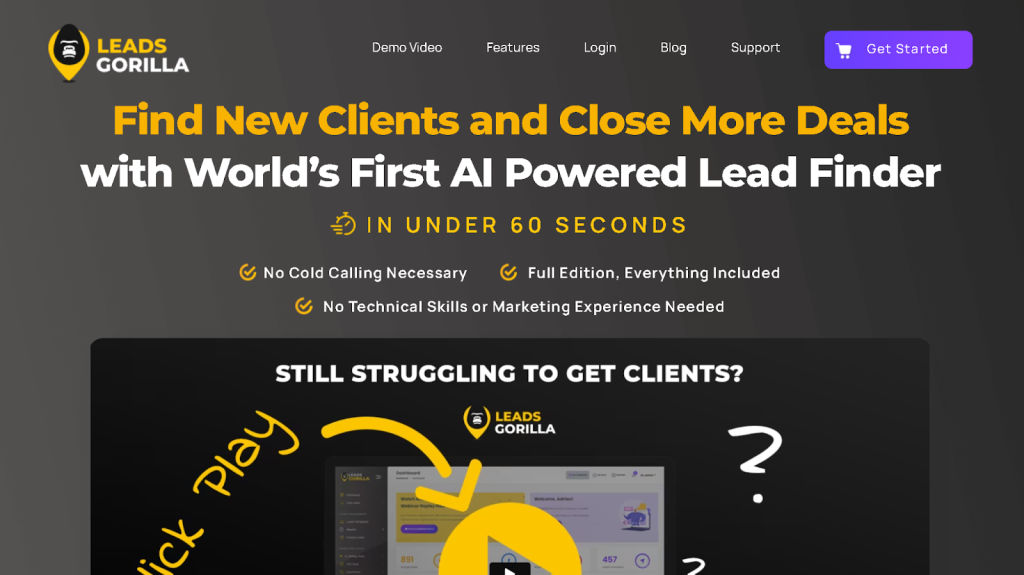
LeadsGorilla is a solution for identifying and engaging with potential clients through automated lead generation and client interaction. It uses AI to find leads, write custom proposals and generate reports for businesses looking to grow in areas like web design, SEO and e-commerce.
Pricing
- $37/month
Features
- AI Lead Generation: Use an AI powered platform to find leads by selecting a business category, keyword or location.
- Automated Reporting: Generate business reports for qualified leads and see who has the most potential for optimization.
- Custom Business Proposals: Use AI to write custom business proposals to increase your conversion rate from leads to paying clients.
- All-in-One Dashboard: Streamline the lead generation process from discovery to nurturing to conversion in one place.
- Business Types: Supports various business types like marketing agencies, e-commerce owners, consultants and startups.
Reviews
Capterra: 3.2/5 ⭐ (6 reviews)
G2: 3.3/5 ⭐ (4 reviews)
What Should You Look Out For When Buying Email Lists?
When buying email lists, you should look out for key factors such as data accuracy, database size, types of contact data and legal compliance.
Accurate Data
When you buy email addresses for marketing or sales, always check for accurate data. Accurate data is crucial for reducing bounce backs and ensuring marketing effectiveness. A good vendor like UpLead guarantees 95% data accuracy. This reduces bounce backs and makes sure your marketing gets to the right people.
Pro Tip: Always ask for a data accuracy guarantee from your list provider to get the most out of your marketing.
Database Size
Size of the database matters because it determines how many contacts you can reach. UpLead has over 160 million leads so you have plenty of email data lists for targeted campaigns. Most vendors allow you to buy email lists by industry to make sure the marketing list fits your specific sector (If you focus on B2C outreach, consider options to buy consumer email lists)
Pro Tip: Focus on the relevance and quality of the database rather than just the size to get the most valuable leads for your business.
Types of Contact Data
Different vendors offer different types of contact data, some offer email addresses and some offer phone numbers like UpLead does. This gives you more options for your marketing strategy. Look for email list companies like UpLead who offer extensive lists of email addresses that are refreshed in real time.
Pro Tip: Make sure you get a list that has multiple types of contact info to diversify your outreach.
Legal Compliance and Opt-In Email Lists
If you purchase email lists, you get instant access to thousands of contacts, it’s crucial to verify quality and compliance Following legal standards like GDPR, CASL and CAN-SPAM is crucial to avoid fines. These regulations dictate how you can use purchased email lists.
Pro Tip: Make sure your list provider complies with the laws to protect your business.
Reputation of Vendor
The vendor’s reputation is a good indicator of list quality. An email list company with a good reputation will provide up-to-date and legal compliant email lists.
Pro Tip: Do your homework by reading reviews and research potential vendors before you buy email data to get the best list.
Exclusive List
Email lists are not always exclusive meaning the same contacts can be targeted by multiple companies. This can lead to lower engagement rates and waste of your investment.
Pro Tip: Look for lists that are exclusive or highly targeted to your niche to get more out of your campaigns.
Email Deliverability and Verification
Email deliverability is key to your campaigns and list purchase strategy. Buying low quality lists can damage your sender reputation and get your emails marked as spam.
Pro Tip: Use email verification tools to clean your lists before launching campaigns to maintain high deliverability rates and filter out invalid email addresses.
Why Should You Buy Email Lists Only From Verified Sources?
Buying from verified sources means you’re following the law, protecting your deliverability and IP reputation and keeping your email marketing legit and performing.
- Legal: Buying from verified sources means you’re following the law like GDPR which requires explicit consent. Ignoring this can mean big fines and brand damage.
- Deliverability: Cleaner lists from verified sources means less chance of high bounce rates and spam traps. This protects your sender reputation so your emails land in the right inboxes.
- Reputable Email Service Providers (ESPs): Most ESPs require opt-in lists. Buying from verified sources meets this requirement so you won’t get penalized or have your email service disrupted. Email service providers have strict policies against purchasing email lists due to potential negative impacts on deliverability and brand reputation.
- Quality of Contacts: Verified sources are more likely to have email leads lists with real interested contacts. This means more positive engagement from recipients.
- Accurate Data: Verified sources provide accurate data, ensuring up-to-date and reliable contact information to help qualify and engage leads effectively in your marketing strategies.
- Brand Reputation: Using verified lists minimizes the risk of looking spammy by making sure recipients have interacted with or shown interest in your business before.
- Customer Trust: Verified lists help build and maintain trust. Recipients are more open to engage with content from sources they have intentionally connected with.
How Can Purchased Email Lists Help You?
Buying an email list gives you instant access to a big audience and speeds up the targeting process. These lists allow you to reach people based on job titles or demographics so you can connect with a relevant audience without having to build your own list from scratch. Reaching the right target audience through targeted email lists is crucial for improving your email list marketing results.
By using these pre-made lists you can focus on your message rather than spending resources on gathering contacts. Owning opt-in email addresses ensures compliance and using the right email list for marketing will help you reduce unsubscribes and driving traffic.
This instant access is especially valuable for launching a marketing campaign or entering a new market where time is of the essence. (This way, you don’t need to set up a landing page to capture contact information from website visitors first. You can just go ahead and start your campaign.)
Plus targeting specific demographics or job titles means your message will resonate more with the recipients and potentially get higher engagement rates.
Just be sure to navigate the legalities and make sure your strategies align with best practices and these lists can be a powerful tool in your marketing toolbox.
FAQ About Buying Email Lists
Here are the answers to common questions about buying email lists:
Email lists are the product of lead generation techniques. They typically have email addresses and include info such as the owner’s name and other data relevant to email marketing.
Email lists are usually generated through lead-generation tools. These tools generate email addresses based on the user’s target audience. It then shows the user’s potential leads and allows them to download up-to-date data for their email marketing efforts.
Email lists are best when bought from lead generation tools. Good lead generation tools give users email addresses and relevant, up-to-date data they can use to send the right marketing messages.
It is not illegal to buy an email list. Legality has more to do with how email addresses are used. For example, emails should always offer ways to opt out of the email database.
Buying the right email list will pay for itself properly and will be generated far faster than an opt-in email database. The right tools allow you to buy email lists that are reliable and profitable. You can also build free email lists, but it takes time and effort.
Yes, multiple lead generation tools have location criteria like city and postal address that allow you to access leads based on their zip code and buy email lists by industry.
Yes, when using a reputable data provider that offers reliable mailing addresses, buying mailing lists can be worth it.
You should ook for guarantees on data accuracy, legal compliance, and regular updates.
No, cheap email lists are not a good idea. While they might seem cost-effective, these cheap email marketing lists often compromise on accuracy and compliance, leading to higher bounce rates.
By definition, email lists typically contain only email addresses, while contact lists contain more comprehensive information such as names, phone numbers, job titles and company details in addition to email addresses.
Build a clean and profitable list
As we’ve seen, not every email list provider lets you buy the right addresses for your email campaigns. Before you purchase an email list, make sure that the data is up-to-date and that the provider complies with all legal standards.
UpLead offers a 95% accuracy guarantee and all the features (such as advanced search filters) you need to buy the best email lists for your marketing campaigns and business growth.
Additionally, with UpLead’s intent data, you’ll get ready-to-buy leads that are more likely to close.
Get started with UpLead today. 👇
Lead generation doesn’t have to be all that painful. With UpLead, you can easily connect with high-quality prospects and leads to grow your company.





